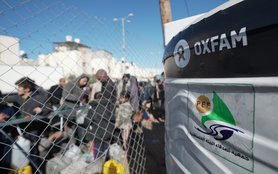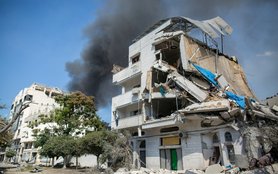The Syria refugee crisis is accelerating with a dramatic increase in the numbers of people flowing across borders, international humanitarian organization Oxfam warned today. In Jordan alone there has been a three-fold increase in the daily rate of people crossing from Syria in the last week. The organization said that extreme winter weather was compounding misery for refugees, with an increase in respiratory infections and pneumonia recorded in clinics in Lebanon and Jordan
Oxfam and its local partners have been distributing blankets and mattresses, heaters and gas oil to help the new arrivals stay warm during the harsh winter. Significant funds are needed to reach more refugees before winter takes its toll.
An estimated 670,000 people have fled violence in Syria to neighboring countries since the onset of the crisis in March 2011. In the past week, there has been a sharp increase in numbers fleeing intensified shelling and fighting. On Thursday alone, 6,400 Syrian refugees arrived in Zaatari camp; while more than 30,000 people have crossed into Jordan since the beginning of the year. Some 16,413 refugees arrived in Zaatari camp in December 2012. In Lebanon, so far this month, more than 24,591 have been registered as refugees.
Francis Lacasse, Oxfam’s Syria crisis response manager said:
“Families have arrived exhausted and traumatized. Some have faced bombs and bullets to get here. Now, they are trying to get through one of the most brutal winters in the last two decades with almost nothing. Most families have to rely on the generosity of relatives and neighbors. Along with local organizations, Oxfam is trying to help thousands of families through this difficult winter period, but we could do so much more if we had more funds.”
In December, the United Nations estimated that the numbers of Syrian refugees would reach more than 1.1 million by June. But it is now predicting this figure will be reached much earlier because of the rapidly deteriorating security situation. Not all refugees register with UN refugee agency UNHCR, which means that the number could be much higher. In May 2012, there were just 70,000 refugees seeking safety in neighboring countries.
This month, the region experienced harsh winter weather conditions, with heavy rain and snowstorms sending temperatures plummeting to below zero. Many of those fleeing Syria have had to endure the bitter cold staying in makeshift, unheated buildings such as garages and sheds, unfinished buildings and self-built tents in informal settlements. Many shelters across Lebanon were flooded, forcing families to move, snow also blocked roads, leaving many areas inaccessible and disrupting delivery of aid supplies. In Jordan’s Zaatari refugee camp, home to nearly 60,000 refugees, tents collapsed or were flooded during strong winds and heavy rains.
New arrivals say they are struggling to stay warm and are especially worried about the health of their children, who have developed respiratory infections. In the last two months, some hospitals and clinics in Lebanon’s Beqaa valley have reported that the number of refugees being treated for respiratory infections and pneumonia account for up to 50 percent of their caseloads; with a figure of 35 percent in Tripoli, north Lebanon. Health workers say these figures are likely to increase since most Syrian refugees are staying in poor and overcrowded living conditions, which lack heating. Some 35 percent of the acute health conditions being treated by medical staff in Zaatari camp are respiratory infections and influenza-like illnesses. There have also been a number of deaths reported in Lebanon and Jordan, with several people being killed in fire accidents as they were trying to stay warm.
Oxfam said that the situation was likely to be worse still in Syria. The UN estimates that 4 million people – nearly one in five of the pre-crisis population – are in need of humanitarian assistance in Syria. Even those who still have homes are suffering from the cold as they are often unable to heat their houses due to shortages of fuel and electricity. Many of the displaced are living in shelters with no winter clothes and no blankets.
Oxfam is currently working in both Lebanon and Jordan. The organization is trying to gain access to people in need in Syria through the UN and official channels and is also negotiating with Syrian organizations to deliver urgent humanitarian aid.
The UN and aid organizations are struggling to meet the needs of the growing number of families fleeing Syria’s conflict. In December, the UN launched its largest ever short-term humanitarian appeal, asking for $1.5 billion to fund its work within and beyond Syria’s borders. So far, this appeal is only three percent funded. A donor conference will be hosted by UN Secretary General Ban Ki Moon in Kuwait this Wednesday, January 30 to bolster the funds for the response to the crisis.
Oxfam’s Syria crisis response manager, Francis Lacasse, continued:
“The tragedy will be if families who fled for their lives seeking safety in a nearby country end up feeling they’ve swapped one misery for another, with their families struggling for support, feeling abandoned - left out in the cold to fend for themselves. We urgently need to bolster the aid response to get help to the growing numbers of people in desperate need. We’d urge everyone to be generous – from donor governments to individuals. With the right determination and resources, we can help make things better for Syrian families who have lost almost everything.”
Oxfam teams are planning to assist 120,000 people in Lebanon and Jordan.


